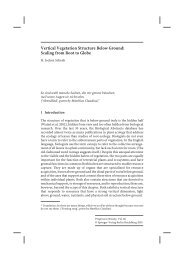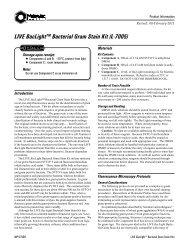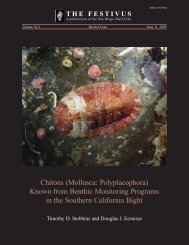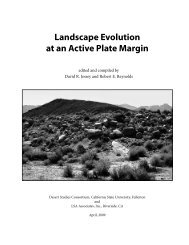2010 Overboard in the Mojave - Biological Science - California State ...
2010 Overboard in the Mojave - Biological Science - California State ...
2010 Overboard in the Mojave - Biological Science - California State ...
Create successful ePaper yourself
Turn your PDF publications into a flip-book with our unique Google optimized e-Paper software.
m. c. reheis and d. m. miller<br />
Figure 7. Deposits of steeply slop<strong>in</strong>g active fan-lake marg<strong>in</strong>s. A, fan-delta and offshore-bar features exposed at site<br />
M06-135, east of <strong>the</strong> North Afton beach ridge. This section, oriented nearly N-S, lies at an oblique angle to SW-trend<strong>in</strong>g<br />
depositional slope, thus apparent bedd<strong>in</strong>g dip is low; where parallel to depositional slope, basal fan deposits slope ~7°<br />
bas<strong>in</strong>ward. Section represents alternat<strong>in</strong>g sequences of barrier structures with frontset and backset beds and deltaic<br />
structures with foreset and bottomset beds. Modified from Reheis et al. (2007b). B, closeup of bedd<strong>in</strong>g <strong>in</strong> part of upper<br />
photograph. 50-cm trench<strong>in</strong>g shovel for scale. C, fan-delta deposits exposed at site M06-141 just north of Shorel<strong>in</strong>e Hill;<br />
note rightward dip of gravel beds <strong>in</strong> middle unit. Photographs by M. Reheis.<br />
lenticular-bedded fan deposits. The dom<strong>in</strong>antly fluvial<br />
units consist of planar-bedded coarse-gra<strong>in</strong>ed sand to<br />
cobble gravel and <strong>in</strong> places, exhibit alluvial clast imbrication<br />
<strong>in</strong>dicat<strong>in</strong>g downslope flow (Fig. 6C). Due to shift<strong>in</strong>g<br />
fan channels and lake levels, fluvial channel fills may be<br />
<strong>in</strong>set with<strong>in</strong> dom<strong>in</strong>antly lacustr<strong>in</strong>e sequences. Fluvial<br />
units that have been modified by nearshore processes<br />
have similar gra<strong>in</strong>-size distribution, but are better sorted<br />
and somewhat better bedded (Fig. 6B). As a result, <strong>the</strong>y<br />
are commonly looser and less <strong>in</strong>durated than <strong>the</strong> purely<br />
alluvial units because <strong>the</strong>y have fewer f<strong>in</strong>es mixed with<br />
<strong>the</strong> coarser sediment. Lake-reworked fluvial deposits are<br />
typified by th<strong>in</strong> lacustr<strong>in</strong>e oncoid carbonate coat<strong>in</strong>gs on<br />
clasts (Awramik et al., 2000) especially at <strong>the</strong> base of each<br />
unit, locally conta<strong>in</strong> Anodonta shells, and may f<strong>in</strong>e upward<br />
<strong>in</strong>to muddy sand. In addition, <strong>the</strong>y may exhibit gently<br />
dipp<strong>in</strong>g frontset (toward <strong>the</strong> lake) and backset beds of a<br />
barrier beach (Fig. 6B).<br />
Steeply slop<strong>in</strong>g active fan-lake marg<strong>in</strong>s are similar to<br />
<strong>the</strong> gently slop<strong>in</strong>g marg<strong>in</strong>s <strong>in</strong> that <strong>the</strong>y are characterized<br />
by lake-modified alluvial deposits. Although such deposits<br />
locally exhibit oncoid coat<strong>in</strong>gs on clasts, <strong>the</strong>y rarely<br />
conta<strong>in</strong> fossils due to <strong>the</strong> higher-energy environment, and<br />
must be recognized on <strong>the</strong> basis of bedd<strong>in</strong>g, sort<strong>in</strong>g, and<br />
stratigraphy. Such deposits are abundantly exposed <strong>in</strong> <strong>the</strong><br />
deeply dissected dra<strong>in</strong>ages around and north of Shorel<strong>in</strong>e<br />
Hill, <strong>in</strong> <strong>the</strong> eastern end of <strong>the</strong> Afton subbas<strong>in</strong> (Fig. 2).<br />
Here, an alluvial-fan complex was built on <strong>the</strong> steep eastern<br />
flank of Cave Mounta<strong>in</strong>. After <strong>the</strong> <strong>in</strong>tegration of <strong>the</strong><br />
Afton subbas<strong>in</strong> <strong>in</strong>to Lake Manix, <strong>the</strong> style of deposition<br />
shifted abruptly from that of coarse-gra<strong>in</strong>ed, angular clastsupported<br />
and debris-flow beds with depositional slopes<br />
of 5–7° and common buried soils formed dur<strong>in</strong>g periods<br />
of stability, to shorel<strong>in</strong>e-modified fluvial beds (Fig. 7;<br />
Reheis et al., 2007b). Site M06-135 is unique <strong>in</strong> this area<br />
<strong>in</strong> expos<strong>in</strong>g <strong>the</strong> architecture of a Gilbert-type fan-delta<br />
and lacustr<strong>in</strong>e bar. The basal unit consists of <strong>in</strong>terbedded<br />
moderately sorted, well-bedded medium-gra<strong>in</strong>ed<br />
to coarse-gra<strong>in</strong>ed sand and pebble to cobble gravel; <strong>the</strong><br />
clasts have th<strong>in</strong> scattered oncoid coats, but <strong>the</strong> gravelly<br />
32 <strong>2010</strong> Desert Symposium
















